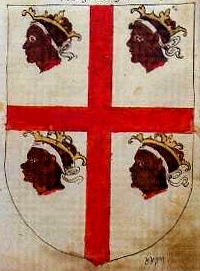Cross of Alcoraz
This article needs additional citations for verification. (April 2021) |

The Cross of Alcoraz is the name given to a heraldic coat of arms and flag made up of the Cross of Saint George, or cross of gules on Argent, with a Maure, or Moor's head, in each quarter. The earliest documented evidence of these arms is in a rare lead-sealed decree from the chancery of Peter III of Aragon, circa 1281, most likely used as the King's Coat of arms, alluding to the spirit of the Crusades and his ancestral namesake, Peter I of Aragon. The arms also appear in the third quarter of the current Coat of arms of Aragon.[1]

According to 14th century sources, the 'Cross of Alcoraz' traditionally originated with the Battle of Alcoraz (in 1096) as King Peter's battle shield, inspired by the legendary miraculous intervention of Saint George in the Reconquista of Huesca.[2]
The earliest depiction of the cross, that of the chancery seal of 1281, shows four Moors' heads with beards but no headbands (or bandages).

Throughout the Middle Ages up to the 20th century, both Aragonese and international variants (viz. flag of Sardinia) have either turned the orientation of the Moor's heads, made them face each other symmetrically, or depicted them as the heads of Saracen kings with open crowns.
This heraldic coat of arms was directly attributed to the Kingdom of Aragon from the mid 15th century and was also adopted as the royal standard of the Kingdom of Sardinia from the second half of the 15th century, when the island was a territory of the Crown of Aragon. In the Sardinian flag, the Moors' heads were blindfolded. In the modern flag of Sardinia, the heads are facing right, and the "blindfolds" have evolved into headbands.
It is pointed out that the adoption of the so-called Cross of Alcoraz by Sardinia most likely dates back to the end of the 15th century, according to a study on the Sardinian flag by Italian author Luisa D'Arienzo.[3]
See also
Notes
- ^ Guillermo Redondo Veintemillas, Alberto Montaner Frutos y María Cruz García López, Aragón en sus escudos y banderas (Aragon in her coats of arms and flags, Zaragoza, 2007 (pub. Colección Mariano de Pano y Ruata, 26), pp. 19-20.
- ^ "He continued the siege of Huesca, the which was long and difficult by reason of the strength of the place, and the resistance of the Inhabitants assisted by Almocaben King of Saragosse and other Moores, and also by some Christians, of which number were Don Garcia, Earl of Cabra, and Don Goncales, vassales to the King of Castille. These being come to succour Huesca with a mighty army, in the year 1096, thinking to raise a seege, had a battaile in the fields with the Arragonois and Navarrois, who wonne it, killing about 30000 Moores, the rest were wholly put to rout and flight, so as the towne despayring of al succours, yielded to Don Pedro King of Navarre and Arragon. Here they forge the ancient armes of Arragon, upon a vision on which the Spanish writers say had appeared to many Arragonois during the combat: that is, Saint George on horse-backe with a shield of steele and a crosse gueles, fighting for the Christians: and that after the defeat there were foure heads of the chiefe Princes of the Moores found: whereupon they say that Don Pedro the King took for the armes of Arragon a crosse gueles in a field argent, betwixt foure Moores heads of the same collour." The Generall Historie of Spaine, written in French by Lewis de Mayerne Turquet, 1583, Translated into English by Edward Grimeston, p.264. Published A Flip and G. Eld, London, 1612.
- ^ Conde, Rafael (2005). "La bula de plomo de los reyes de Aragón y la cruz de Alcoraz" [The leaden seal of the Kings of Aragon and the Cross of Alcoraz.] (PDF). Emblemata. Retrieved April 25, 2024.
Bibliography
- CONDE, Rafael , en "La bula de plomo de los reyes de Aragón y la cruz «de Alcoraz»", Emblemata, XI (2005), pp. 59–82 ISSN 1137-1056.
- MONTANER FRUTOS, Alberto, El señal del rey de Aragón: Historia y significado, Zaragoza, Institución «Fernando el Católico», 1995. ISBN 84-7820-283-8.
- REDONDO VEINTEMILLAS, Guillermo, Alberto Montaner Frutos y María Cruz García López, Aragón en sus escudos y banderas, Zaragoza, Caja de la Inmaculada, 2007 (Colección Mariano de Pano y Ruata, 26), pp. 19–20. ISBN 978-84-96869-06-6.
- DE MAYERNE TURQUET, Lewis, in "The Generall Historie of Spaine", p. 264, written in French by Lewis de Mayerne Turquet, 1583, Translated into English by Edward Grimeston, Published by A Flip and G. Eld, London, 1612.
